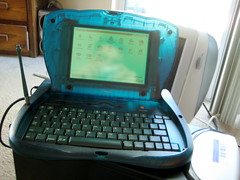Since my eMate 300 arrived at the end of last summer, I’ve struggled with ideas on how to use it. I bought mine mainly as a testing machine; my MessagePad 110 could only run Newton OS 1.x applications, and I wanted to experiment with more recent Newton apps. Also, eMates don’t have the portability and flexibility of their MP2x00 cousins.
So, what to do? It’s only recently, as I think back to the eMate’s original use (education, writing, word processing), that I’ve thought of a practical use for the little green machine: a journal writer.
I’ve been a writer as long as I can remember. As a kid, I used a typewriter to hammer out short stories. When I discovered the computer, it opened up a whole new world for me. I grew up to be editor of my high school and college newspaper, earned my degree in journalism, and went on to be a professional public relations writer. I live and breathe the written word.
A few years ago, I picked up journaling after a long hiatus. A plain notepad and pen have been the victims of random thoughts since I graduated college in 2003. After using a keyboard for so long, though, I notice my hand fatigues after only a few paragraphs. It’s no laughing matter.
I thought about using one of my Mac SEs as a journaling machine, just as an excuse to turn on of the little guys, but the SEs lack the true portability I was looking for. Laptops are fine – I have two iBooks – but finding excuses to use my classic Apple hardware was the goal. The eMate was just what I was looking for in a writing machine.
At home, the eMate works fine. But the rechargable battery is dead, and it’s not like a standard MessagePad with replaceable batteries. The eMate’s battery is wired in. So my next project is to find a usable eMate battery and replace my dead one.
When that happens, the eMate’s portability will be good enough to carry with me on vacations, trips to the coffeeshop, and even local performances or exhibits, where I can type down my thoughts. The smaller eMate keyboard will take some getting used to, but I’ve used it a few times already, and it’s not that big of a change.
In the meantime, I’m going to use Newton Works (with, perhaps, a few add-ons) to keep an electronic journal. I may search for other word processor apps, just to test the options, and implement a folder structure by year for organization. Now that I have Newton-to-OS X syncing down pat, I can even export my entries as text files – just in case any of them work as a blog post.
It’s hard to justify owning an eMate just for testing and projects alone. Over time, I can think about other uses for it other than journaling – like recipe-keeping (that old cliché) or even Twittering. Who knows?
All this will give me an excuse to poke around the Newton 2.0 interface a bit more, try out some apps, and goof around with my newest Newton. Stay tuned – the next Newton Poetry post could be typed out on an eMate keyboard.







